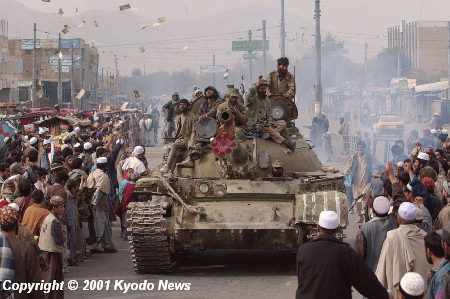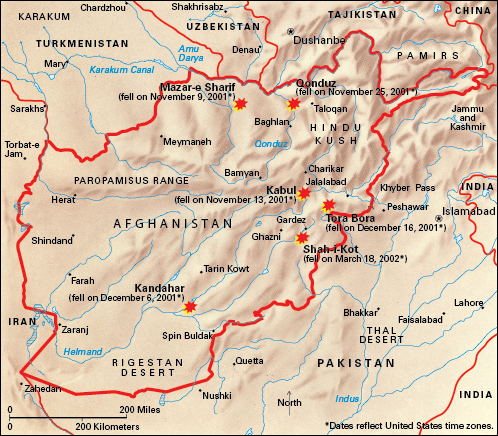Taliban is a militant Sunni Islamic political group. The group gained control of most of Afghanistan in the mid-1990’s and sought to turn Afghanistan into an Islamic state. In 2001, the United States and its allies helped Afghan opposition forces, known collectively as the Northern Alliance, topple the Taliban. However, the Taliban remained active in the region, regrouped, and eventually regained some territory. As U.S. forces withdrew from Afghanistan in 2021, Taliban forces rapidly seized control of additional districts and cities, the capital, and the government. The word taliban (also spelled taleban) means seekers after knowledge. The name refers to the group’s origin in Islamic schools.

While in control of Afghanistan from the mid-1990’s to 2001, the Taliban enforced strict adherence to their interpretation of Islamic laws and practices. These included restrictions on most modern forms of entertainment, as well as on dress and personal grooming. For example, the Taliban forced men to wear beards and women to completely cover their heads and faces in public. Those who violated the Taliban’s law were severely punished.
The Taliban formed in 1994. The group sought to end the lawlessness that had resulted from years of war in Afghanistan. From 1979 to 1989, the Soviet Union occupied Afghanistan to support the country’s pro-Communist government against rebels. After the Soviet forces withdrew, Afghanistan descended into civil war as various factions vied for power. The Taliban drew their forces from Afghan and Pakistani Muslim students, Afghan refugees who had fled to Pakistan, former rebel fighters, and former Communist soldiers. Many of the group’s members belonged to Afghanistan’s dominant Pashtun ethnic group. The Taliban initially established their power base in southeastern Afghanistan near the border with Pakistan. Pashtuns form the majority in that area.
With assistance from Pakistan’s military, security, and intelligence services, the Taliban captured Afghanistan’s second largest city, Kandahar, in 1994. In January 1995, the group seized the province of Ghazni, northeast of Kandahar. Throughout 1995, Taliban rebels strengthened their position in southern Afghanistan. In September 1995, they took the western city of Herat. A year later, they seized Afghanistan’s capital and largest city, Kabul. The government forces retreated to northern Afghanistan.
In 1997, Taliban authorities changed the official name of the country to the Islamic State of Afghanistan. But only three countries recognized the Taliban as a legal government—Pakistan, Saudi Arabia, and the United Arab Emirates.
In 1998, the United States accused the Taliban of harboring the Saudi-born millionaire Osama bin Laden. United States authorities wanted bin Laden in connection with terrorist attacks against two U.S. embassies in Africa that had occurred that year. The United States launched missile strikes against suspected terrorist training camps in Afghanistan. A Taliban spokesman acknowledged that bin Laden was in Afghanistan as a guest of the Taliban. In 1999, the United Nations imposed trade sanctions against Afghanistan for refusing to surrender bin Laden.
On September 11, 2001, terrorists hijacked airplanes and used them to attack the World Trade Center in New York City and the Pentagon Building near Washington, D.C. The attacks killed thousands of people from many different countries. The United States accused bin Laden and al-Qa`ida, his terrorist organization, of planning the attacks. United States officials demanded that the Taliban surrender bin Laden and shut down terrorist training camps in Afghanistan. The Taliban refused. As a result, the United States and its allies launched a military campaign against them in October. The campaign included massive air strikes in support of Afghan opposition forces, which enabled them to drive the Taliban from power in late 2001.

Many surviving Taliban and Qa`ida members fled across the border to northern Pakistan, where they regrouped. The Taliban that emerged was significantly different from its earlier version. Splinter groups no longer saw Afghanistan as the sole battleground. Instead, some turned their attention to Pakistan. Observers note that the Taliban today seems to be more of a network of shifting alliances among various regional groups than a unified organization.
From safe havens along the Pakistani border, the Taliban launched attacks against Afghan government forces and their allies, the United States and the North Atlantic Treaty Organization (NATO). They also attacked Pakistani politicians and anti-Taliban activists. Some international affairs experts accused members of Pakistan’s security services of supporting the group. The United States began to use unpiloted aircraft called drones to combat the Taliban in Pakistan’s remote border regions. On May 2 (May 1 in the United States), 2011, American military forces killed bin Laden in Abbottabad, a city northeast of Islamabad, Pakistan. In 2015, Taliban leaders confirmed that the group’s long-time leader, Mullah Omar, had been dead since 2013.
The United States and NATO formally ended their combat missions in Afghanistan in December 2014, but thousands of troops remained in the country in advisory and support roles. Taliban fighters began to increase their presence in Afghanistan in 2015. Afghan security forces continued to battle them. In 2017, some U.S. troops were also deployed in combat roles.
In 2018, representatives of the United States and the Taliban began to hold talks on conditions under which U.S. troops might be withdrawn from the country. However, the Taliban refused to engage in negotiations with the Afghan government. In February 2020, the Taliban signed an agreement with the United States aimed at eventually ending the war. The Taliban agreed not to allow terrorist organizations, such as al-Qa`ida and the Islamic State (ISIS), to operate from bases in Afghanistan, and the United States agreed to a gradual withdrawal of its troops from the country. In September, representatives of the Taliban and the Afghan government began to meet for negotiations. However, violence in Afghanistan continued. Taliban threats and violence against members and supporters of the Afghan government mounted.
Taliban attacks aimed at expanding control over additional territory increased in 2021 as U.S. and NATO troops withdrew. The Taliban advances sped up during the summer months, and hundreds of thousands of Afghans fled. In August, several major cities fell to the Taliban. On August 15, Taliban forces entered and took control of Kabul. Ashraf Ghani, Afghanistan’s elected president, fled the country. In September, the Taliban’s leaders installed an interim prime minister and cabinet. Soon, they also began to reimpose restrictions on dress, education, and other activities.
